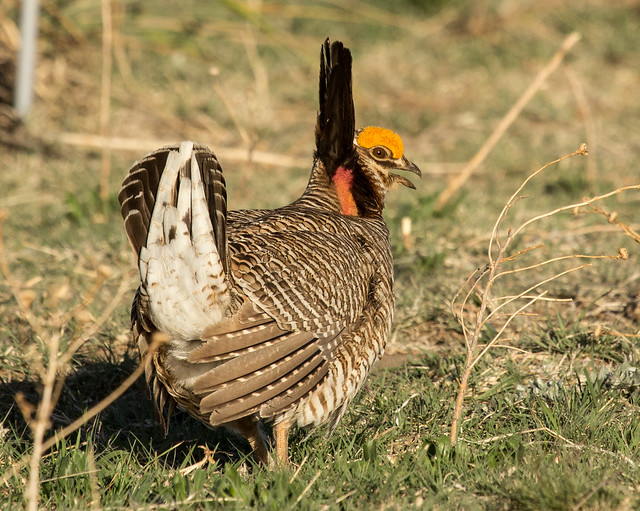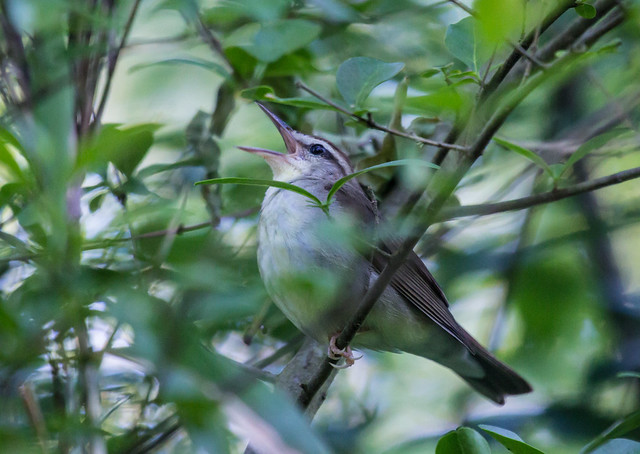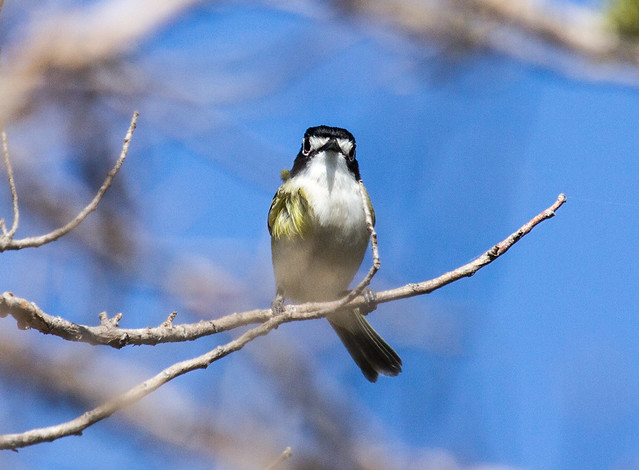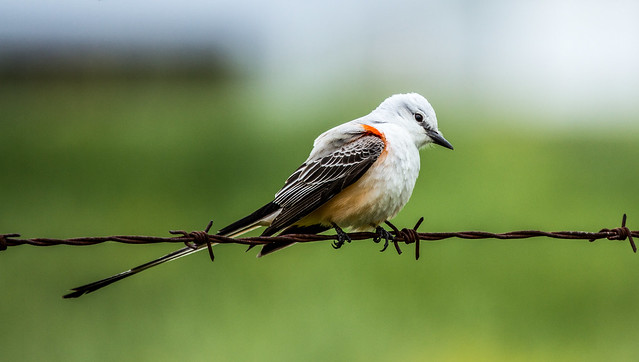Last October, I got an email from John Kennington in
Oklahoma, inviting me to speak at this year’s Lesser Prairie-Chicken Festival
in Woodward, Oklahoma, which takes place during the last weekend of April. Of
all the birding festivals on the continent, this was the one I’ve most badly
wanted to attend, so I was elated. As of the festival, I’d been on the planet
for exactly 3,260 weekends starting on the Sunday on which I was born, and of
all those weekends, this wonderful birding festival ranks in the
top ten.
Part of what made it so wonderful is that I was in Oklahoma—one
of my favorite states of all. Everyone I’ve met in Oklahoma has been warm and friendly,
and the birds are utterly splendid. Three of my favorite birds are localized Oklahoma
specialties—Swainson’s Warbler in the southeast, Lesser Prairie-Chicken in the
west, and the Black-capped Vireo in the middle.
And one of the most splendid
birds in the universe is ubiquitous just about everywhere in the state from
spring through fall—the Scissor-tailed Flycatcher. How could I not be in love
with Oklahoma?
My perfect weekend started at 3:30 am on Saturday, April 26.
I’d been staying at the Northwest Inn in Woodward,
and we were leaving promptly at 4:30 to go to a prairie-chicken observation
blind on the Selman Ranch. This is something I’ve yearned to do ever since I
discovered how much Sue Selman, the owner, has done to protect the chickens on
her land and to get the word out to other landowners about how wonderful this
bird is and how to help it. She's been one of my real heroes.
She has portable blinds set up that each
accommodate 2 or 3 people, and she can set them wherever the view is best while
not disturbing the birds. I’ve seen Lesser Prairie-Chickens twice before, but
never from such close range. I was absolutely thrilled.
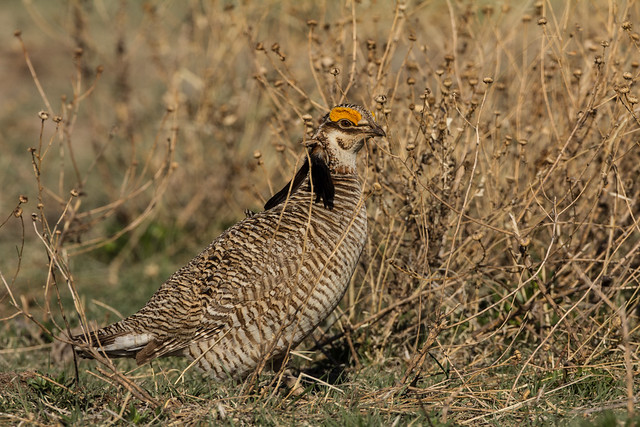

Prairie chickens are in steep decline, primarily due to
habitat loss, and we lose more quality habitat every day as more people sell or
lease their land for energy production or allow cattle to overgraze it or
convert it to farm fields. Despite all Sue’s hard work, her property is edged
in a few places by wind farms—and prairie chickens and other grassland grouse
simply cannot abide vertical structures, including trees, oil jack pumps, and
wind turbines, within their view, especially when engaging in breeding or
nesting behaviors. Prairie chickens and sage grouse are tasty birds that are
fairly easy for hawks and falcons to take; the vulnerable grouse may well
associate vertical structures with hawk perches. This is why agricultural and
energy interests have lobbied heavily and spent enormous amounts of money to
oppose the listing of these birds for protection under the Endangered Species
Act. The only way their numbers could possibly be restored to even a tiny
fraction of historical numbers would be to restore large swaths of healthy
prairie grassland.
And even as their habitat dwindles, leading to inevitable
declines, Lesser Prairie-Chickens suffer additional and avoidable mortality. Hunters
and falconers can still legally take them in some states even though they’re
clearly not “harvesting the surplus population” when there is no surplus
population when a species is declining. And more individual prairie chickens
die in collisions with fences than any other single cause.
Unnecessary fencing should always be removed to protect
grassland species, especially grouse, but when it can’t be removed, a simple
and inexpensive, albeit labor intensive, alternative is extremely effective at
protecting birds. Marking fences every 2 feet or so with white plastic pieces, about
the size of credit cards, reduces kills to virtually nothing.
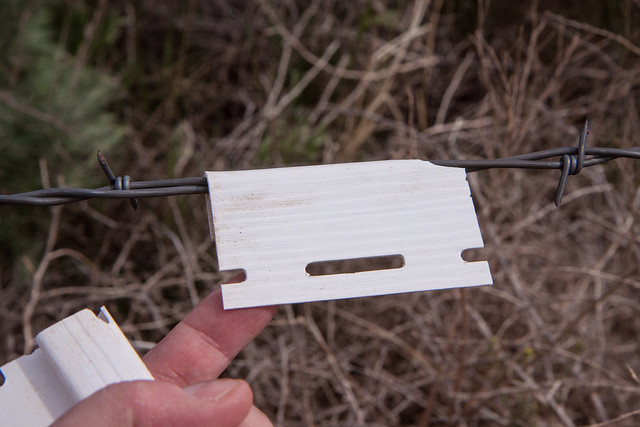
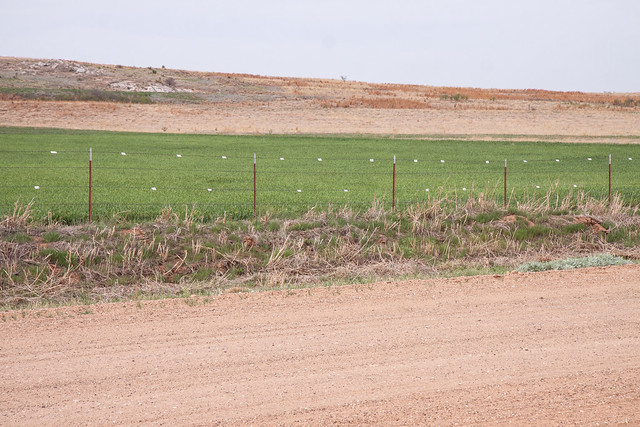
I was thrilled that after a lovely time watching the birds on the Selman Ranch displaying, and then eating a delicious breakfast at the ranch house, we were taken to a stretch of fencing and asked to put a couple of handfuls of those plastic markers on the wires. It was fast and easy, and made a perfect end to the morning, allowing us to do a little thing to help ensure that these gorgeous birds could continue their spectacular courtship long into the future. It was a great morning, with another one to come.
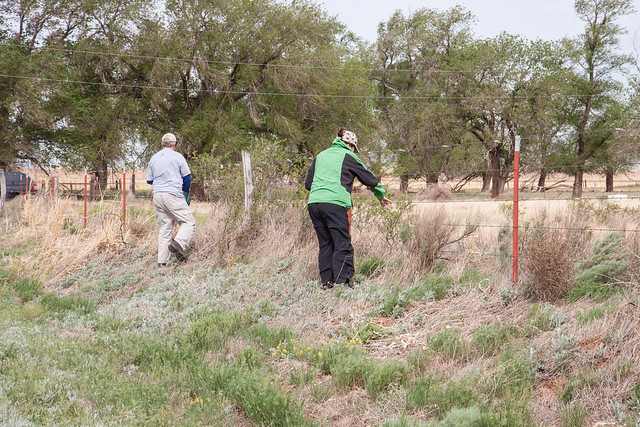


I was thrilled that after a lovely time watching the birds on the Selman Ranch displaying, and then eating a delicious breakfast at the ranch house, we were taken to a stretch of fencing and asked to put a couple of handfuls of those plastic markers on the wires. It was fast and easy, and made a perfect end to the morning, allowing us to do a little thing to help ensure that these gorgeous birds could continue their spectacular courtship long into the future. It was a great morning, with another one to come.

One of the special activities offered for photographers
participating in the Lesser Prairie-Chicken Festival was a trip to a lek where a
few dozen Lesser Prairie-Chickens are still present and display surprisingly
close to the blind. I couldn’t imagine getting better looks than I had on the
Selman ranch, but what the heck?
In order to see displaying prairie chickens without spooking
them, you need to arrive before first light so the birds won’t know you’re
there. The blind for this trip was further than the Selman Ranch—all the way in
Canadian, Texas, in the Panhandle, and so we had to leave earlier, meaning I
had to get up at 3 am. But the thrill of seeing prairie chickens easily
overrides sleepiness for me, so on both mornings I woke up by myself 5 minutes
before my alarm went off.
The photographer’s blind is large enough to accommodate 5 or
even 6 people, but the day I was there, it was just me and one other guy named
Harald Miller. He had rented a ginormous Canon 800-mm lens for the day, so he
positioned himself in a corner where he could point the lens out either of two
windows. I picked a spot right in the center. Within minutes of getting all set
up, while it was still quite dark, we started hearing the chickens gathering. Greater
Prairie-Chickens make a low, hollow booming sound with their air sacs as well
as lots of chattering squawks and other sounds. Lesser Prairie-Chickens don’t
make those booming sounds, but their chattering is quite thrilling even before
the birds can be made out in the murky darkness.
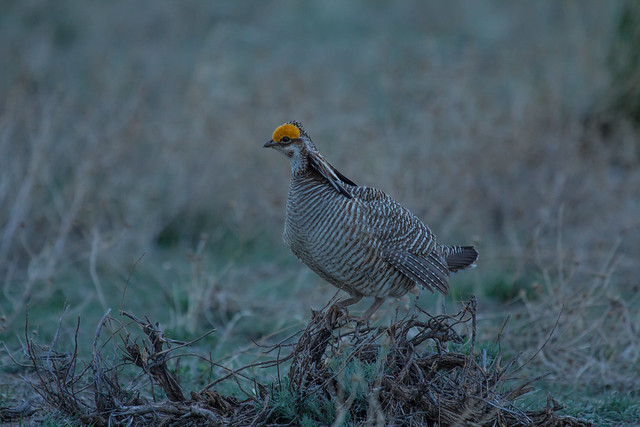

Female prairie chickens come to leks to choose the most
vigorous males—the ones most likely to produce genetically superior young. They
seem to pay particular attention to the first males to arrive in the growing
light—not only are those males likely to be strong and powerful, but the
females can choose their favorite, mate with him, and get out of the open lek
area before hawks are on the wing. Sure enough, the only female I got a photo
of came and left well before sunrise.
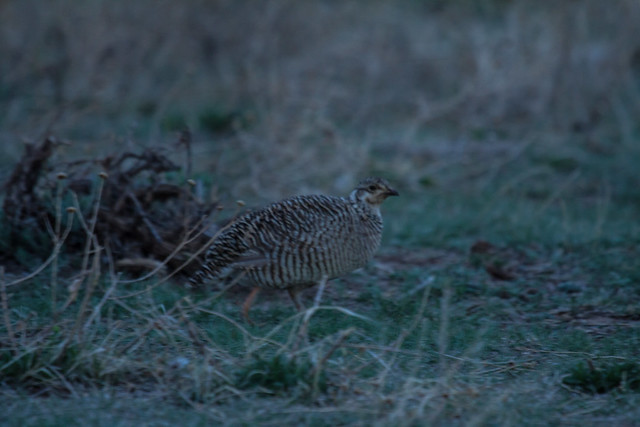

The overcast skies made the light soft and pleasing at dawn.
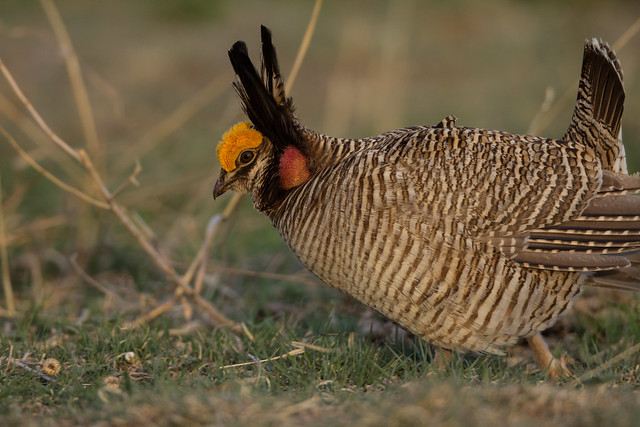
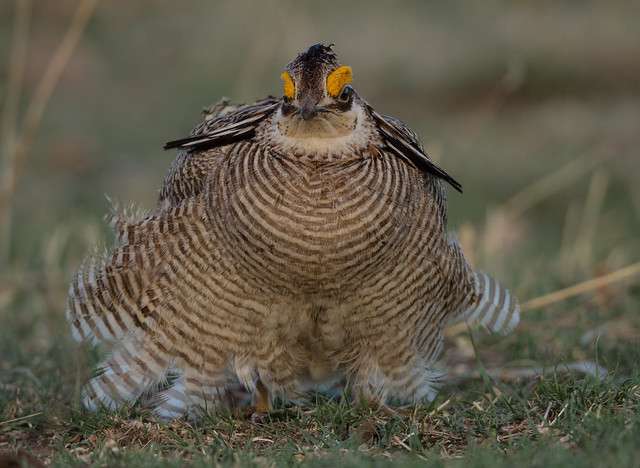
When the sun finally did come out, the prairie chickens looked utterly glorious. I mostly focused on one male who was defending the territory right outside my window. I got to watch him eating, resting, and displaying.
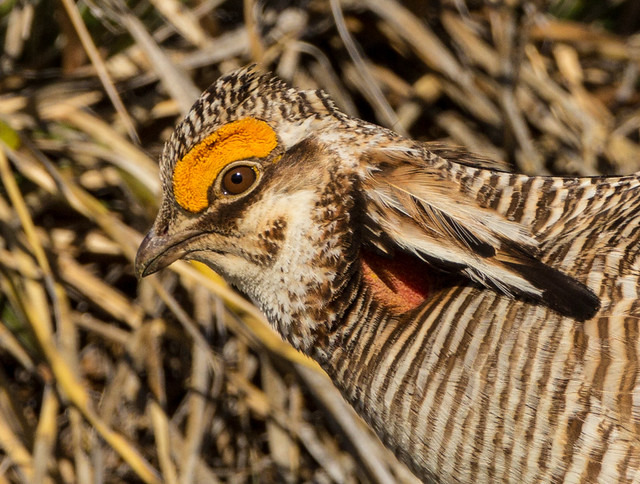

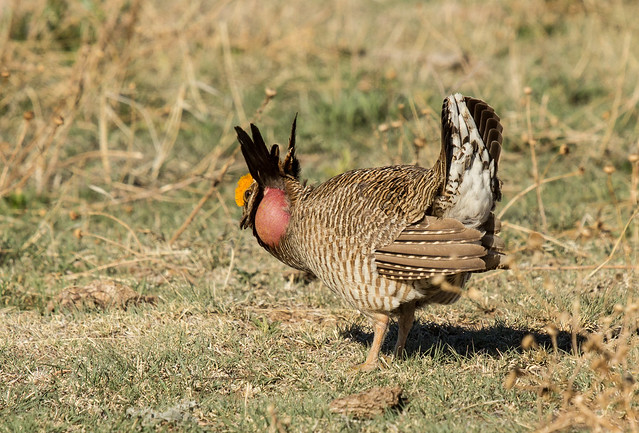
A different cock would periodically walk in from the right. I surmised that he was one of last year’s young by the fact that he was slightly smaller and his pink air sacs were tinged with yellow.
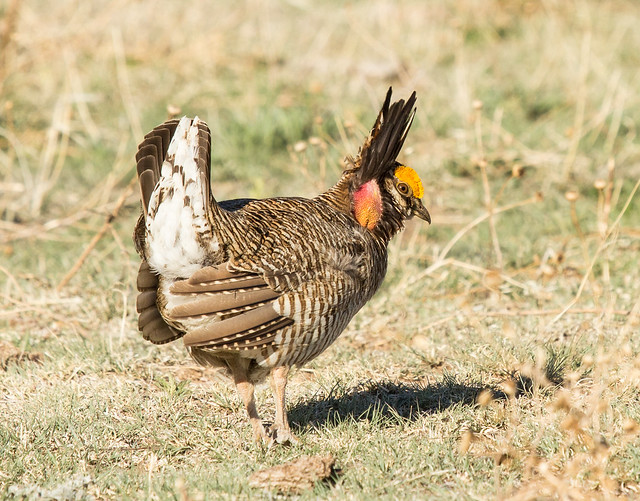
He was fairly easy for my bird to chase off. The bird entering occasionally from the left seemed more an equal. The two faced off at the borders of their defended space frequently. Occasionally they’d come to blows, but they were quite literally playing chicken, and often one bird broke the stare down and just retreated back within his own territory.
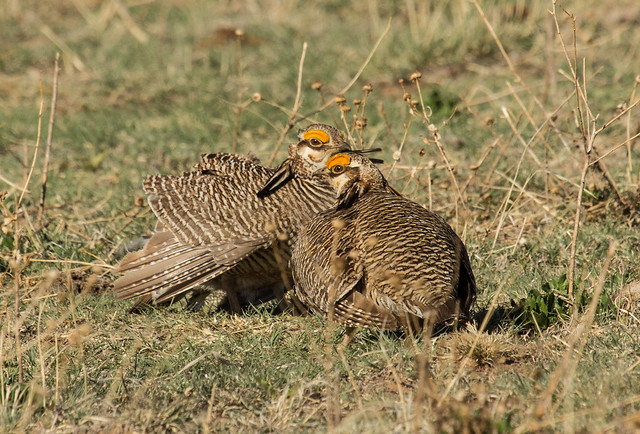
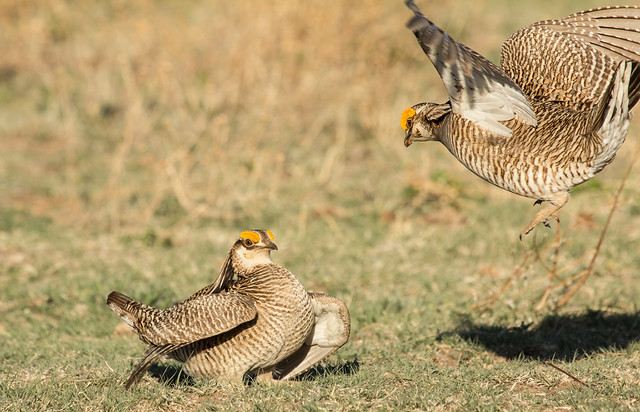
But sometimes they both jumped up in a flurry of wings and waged a battle that lasted just a few seconds. I had trouble predicting these battles—I couldn’t perceive any slight change that triggered one, so didn’t manage to catch much with my camera. A female turned up at least once that I could barely see from the corner window, but I was rooted to my own window and my one special male, so I didn’t even try to photograph her. Harald Miller had signed up for the photographer’s package for all three days, so he could be sure of getting at least one good morning, and he said this was the best of the three. He moved around in the blind more than I did, and when he was photographing from my other side, he let me hook up my camera to his 800 mm lens—I got some amazing close-ups with it. After an hour or two, the birds started spending time eating and loafing as well as displaying, but when one would spot another, it would instantly get into display mode.



When the sun finally did come out, the prairie chickens looked utterly glorious. I mostly focused on one male who was defending the territory right outside my window. I got to watch him eating, resting, and displaying.



A different cock would periodically walk in from the right. I surmised that he was one of last year’s young by the fact that he was slightly smaller and his pink air sacs were tinged with yellow.

He was fairly easy for my bird to chase off. The bird entering occasionally from the left seemed more an equal. The two faced off at the borders of their defended space frequently. Occasionally they’d come to blows, but they were quite literally playing chicken, and often one bird broke the stare down and just retreated back within his own territory.


But sometimes they both jumped up in a flurry of wings and waged a battle that lasted just a few seconds. I had trouble predicting these battles—I couldn’t perceive any slight change that triggered one, so didn’t manage to catch much with my camera. A female turned up at least once that I could barely see from the corner window, but I was rooted to my own window and my one special male, so I didn’t even try to photograph her. Harald Miller had signed up for the photographer’s package for all three days, so he could be sure of getting at least one good morning, and he said this was the best of the three. He moved around in the blind more than I did, and when he was photographing from my other side, he let me hook up my camera to his 800 mm lens—I got some amazing close-ups with it. After an hour or two, the birds started spending time eating and loafing as well as displaying, but when one would spot another, it would instantly get into display mode.

I took over 3,000 photos of the Lesser Prairie-Chickens, and
also got a few shots of Horned Larks and a cowbird.
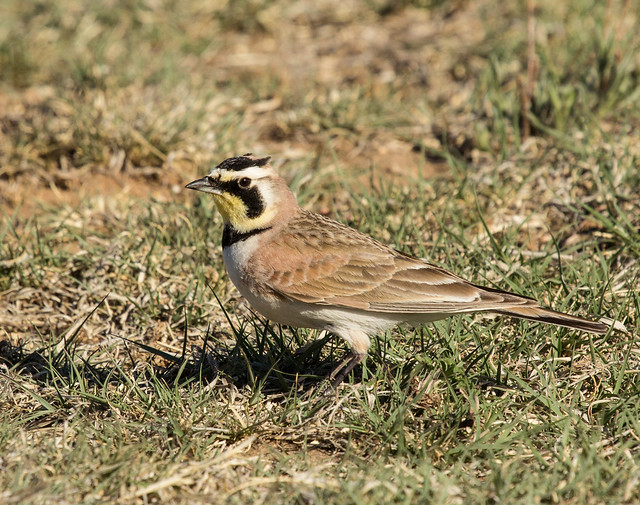
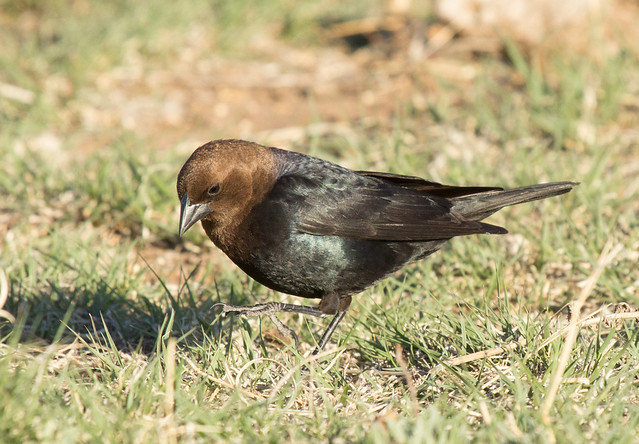
The prairie chickens spooked just once all morning and were back within two or three minutes. I was spellbound for four hours—not the least bit ready to leave—but finally, some time between 9 and 10, they all suddenly took wing. That was the end of their display period for the day. After we packed up and closed up the blind, we got to see pronghorn antelopes on the way out. Could the day possibly have been better?
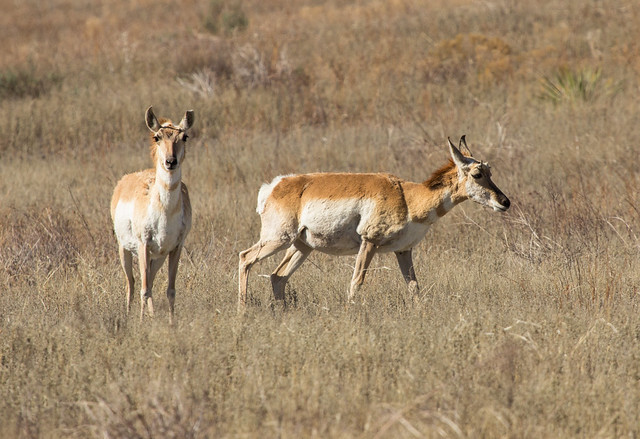


The prairie chickens spooked just once all morning and were back within two or three minutes. I was spellbound for four hours—not the least bit ready to leave—but finally, some time between 9 and 10, they all suddenly took wing. That was the end of their display period for the day. After we packed up and closed up the blind, we got to see pronghorn antelopes on the way out. Could the day possibly have been better?

I’m getting to enjoy the whole thing all over as I process
my photos, which I’ll treasure for the rest of my life. And there were plenty of other cool field trips and great birding spots as well. I had an especially lovely time at Boiling Springs State Park, where a Barred Owl flew out at mid-morning, and I had some of my best looks ever at a few territorial Louisiana Waterthrushes. On one field trip, the participants even found a few Evening Grosbeaks! That LesserPrairie-Chicken Festival is one of the most splendid experiences I’ve ever had
in my 62 years. I can’t wait to return.
